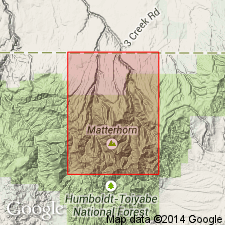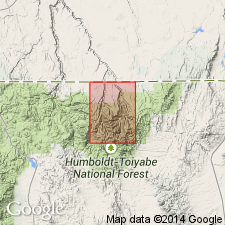
- Usage in publication:
-
- [Dead Horse tuff*]
- Modifications:
-
- Original reference
- Dominant lithology:
-
- Tuff
- AAPG geologic province:
-
- Great Basin province
Summary:
Pg. 304-305. [Dead Horse tuff.] Massive dull-green to reddish- and pinkish-gray biotite quartz latite welded tuff. Thickness about 5,000 feet. Grades upward into coarse conglomerate which is overlain by Jarbidge rhyolite (new). Rests on Paleozoic limestone. Present in Jarbidge quadrangle, Elko Co., northeastern NV. Dead Horse Tuff adopted by the USGS.
USGS currently [ca. 1966] considers the Dead Horse Tuff to be late Eocene in age.
Source: US geologic names lexicon (USGS Bull. 1200, p. 1056).

- Usage in publication:
-
- Dead Horse tuff*
- Modifications:
-
- Principal reference
- Geochronologic dating
- Dominant lithology:
-
- Dacite
- Quartz latite
- Tuff
- AAPG geologic province:
-
- Great Basin province
Summary:
Pg. M7, geol. map. Dead Horse tuff. Chiefly a crystal-vitric tuff with small amounts of sandstone. White to pale gray, locally greenish or chocolate with leaf impressions and fish scales. Ranges in composition from biotite-hornblende dacite through biotite-hornblende quartz latite to biotite rhyolite. Thickness about 5,200 feet, though only upper half of unit is exposed within quadrangle. Conformably overlain by Meadow Fork formation (new). Age is late Eocene; K-Ar age on biotite 39.9 Ma (D.I. Axelrod, personal commun.). Adopted by the USGS.
Type locality (part): Dead Horse Creek, in Copper Basin, southwestern corner of Jarbidge quadrangle, Elko Co., northeastern NV. Notable exposures in and south of Copper Basin, and in Seventy Six Creek area, east of Copper Basin.
Source: Publication.
For more information, please contact Nancy Stamm, Geologic Names Committee Secretary.
Asterisk (*) indicates published by U.S. Geological Survey authors.
"No current usage" (†) implies that a name has been abandoned or has fallen into disuse. Former usage and, if known, replacement name given in parentheses ( ).
Slash (/) indicates name conflicts with nomenclatural guidelines (CSN, 1933; ACSN, 1961, 1970; NACSN, 1983, 2005, 2021). May be explained within brackets ([ ]).

